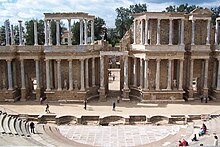Mérida is the capital of the Extremadura region in Spain. Founded in 25 BC, Mérida was once the capital of the Roman province of Lusitania. The city still contains numerous well preserved Roman ruins, the group of which were declared a UNESCO World Heritage site in 1993.
Get in
By train
The RENFE station in Mérida is located on Calle Cardero. There are four trains to and from Cáceres (trip time: 1 hr.), five trains to and from Madrid (4.5-6 hours, 18.45-27 Euros one-way), one to and from Seville (3 hr.), and seven to and from Badajoz (1 hr.)
By bus
The Bus Station, is at Ave La Libertad s/n across the bridge (Puente Lusitania) from the central part of town with the following companies:
- ALSA, ☏ +34 902 42-22-42.
- [dead link] Avanza Bus y Suroeste (Southwest), ☏ +34 924 37-14-04. Southwest Bus is a subsidiary of Grupo Avanza. Travels primarily towards Madrid via Trujillo
- Eurolines, ☏ +34 902 40-50-40. International connections between Portugal, Spain, France and into the rest of Europe.
- FLIXBUS. International bus connecting Lisbon, Merida, Biarritz/Bayonne, Bordeaux and Paris Passengers transfer buses or to trains in Paris and Bordeaux to continue to additional destinations in France, Germany, Switzerland etc.
- LEDA, ☏ +34 924 37-14-03. Travels primarily on Hwy A66/E-803 (Zafra - Villafranca de los Barros - Almendralejo-Merida - Caceres); A5/E90 (Merida - Badajoz) to serve various places in the surrounding regions of Extremadura.
There are fewer buses to Madrid, but connections to Seville (6-8 busses per day) are much better.
By car
The N-V superhighway passes through Mérida from Madrid or Lisbon.
Get around
See
Roman Ruins

Roman ruins in Mérida are a mixture of ticketed and free sites.
At the ticket booth of the sites that require paid entry, there is a combo ticket for €15, which is generally only slightly more expensive than the entry to just one site. With that said, the theater-amphitheater duo site seems to draw the bulk of the crowds, and it may be better to start at a smaller site, which avoids waiting in long lines to buy the combo ticket. You will also be given a map to the sites (both free and paid) around the city. The combo ticket does not include the notable Roman Art Museum across the street from the amphitheater. The Roman Art Museum is only €3.
- 1 Roman Theater. and 2 Roman Amphitheater. The star attraction of the Roman sites in Mérida. The theater (used for plays) and amphitheater (used for gladiator fights and spectacles) are next to each other, and both are excellently preserved. During the summer the theater is still used for flamenco and other shows. Ticket required.
- Casa del Mitreo. Uncovered remains of an old Roman mansion. Many original floor mosaics still visible. Ticket required.
- 3 Roman Bridge (Puente Romano). Once the longest bridge in the Roman Empire. Part original Roman construction, part restoration from the Visigoth era. Still used daily by pedestrians. The Alcazaba is on the Merida side of the bridge.
- 4 The Alcazaba. Remains of a Moorish fortress built using material and part of the structure of the original Roman city walls. Can walk along the outer wall for a view of the river and old bridge. Ticket required.
- 5 Templo de Diana (in the city center). Ruins of a large Roman temple, dating from the founding of the city. Parts of the structure were later reused in the Moorish period and after. Free to view.
- Portico del Foro. Uncovered section of foundation of the old city Forum, with a few reconstructed columns. Free to view.
- 6 Arch of Trajan. Large archway that was once one of principal entrances to the city. The surrounding structure has been lost but the arch itself remains standing in the midst of the modern city. If you drive a car, you can pass below it on a public street (put Calle Trajano 8 in your GPS).
- 7 Circo Romano (Hippodrome). The ruins of an ancient stadium where chariot races would have been held. Slightly outside of the city center, and the entrance is only on the end closes to the city. Walking to the wrong side of the stadium is easy to do. Ticket required for entry.
- 8 Rabo de Buey-San Lázaro Aqueduct. Across the street from the Circo Romano, three pillars are all that remain of the structure of the Roman aqueduct. Better preserved remains from a 16th century aqueduct also stand in the same location. Free.
- 9 Acueducto de los Milagros. Large, impressive section of a Roman aqueduct (three levels high) that runs across the center of what is now a city park. Free to visit.
- Zona Arqueológica de Morería. A small, mostly derelict section of remains of the city entrance next the river, that has been uncovered. Ticket required.
- 10 Roman Art Museum. Spectacular collection of mosaics and sculptures. Does not accept combo ticket. Entry €3.
Medieval and Modern Sites
The central Plaza de España has the Mérida Palace Hotel, which is a well-preserved historical building now hosting a 5 star hotel. Additionally, this plaza has the modern art "Palácio de la China", which is a visual riot and not at all Chinese.
- Visigoth Collection. Good collection of sculptures from the Visigothic era of Mérida. Free entry.
Do
Buy
Eat
Look for Torta del Casar, served at most restaurants.
Some places also make stuffed red peppers with a variety of fillings like fish, cornmeal, and lamb.
There is a variety of cheese made with paprika, but there are numerous names for it.
Also of note is the local red wine "Ribera del Guadiana".

